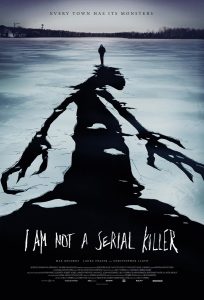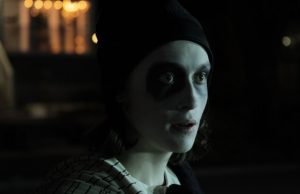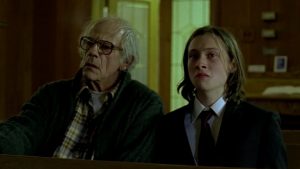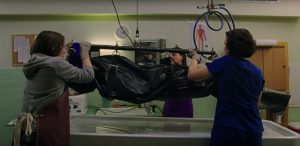
I have not read the Dan Wells novel this film is adapted from, but I suspect it to be more gripping than this. At least I hope so, given its acclaim. I can’t imagine it’s as one-dimensional as Christopher Hyde & Billy O’Brien’s screenplay, which is filled to the brim with cliches and on-the-nose dialogue. If it is, it’s possible it reads better than it plays out on screen, not seeming as corny as it does in motion. That or its dark humor and supernatural elements are more prevalent as opposed to falling by the wayside in favor of repetitive stalking sequences. These sequences are atmospheric at first, but run their course rather quickly and are too reminiscent of the cinematography found in “Halloween” to stand on their own two feet. It’s as if cinematographer Robbie Ryan threw in the towel halfway through production.
Those stalking sequences belong to John Wayne Cleaver (Max Records), a teenager diagnosed by his therapist as a sociopath in development. Said therapist, Dr. Neblin (Karl Geary), comforts his patient by explaining that, just because his prognosis is that he’ll become a serial killer, doesn’t mean he actually will become one. It’s just a premonition that can be broken by John’s own free will. His way of combatting his sinister thoughts is to kill everyone with kindness. This gets turned on its head later on after he spells this out to the school bully, informing him he sees him as nothing more than a cardboard box he’d like to cut open to see what’s inside. As I type all of this out, I realize how darkly humorous and engaging this may seem, giving credence to my theory.

It certainly wasn’t engaging when played out on screen thanks in part to Billy O’Brien’s lousy direction. He tackles the dark humor as if it existed in a lame sitcom, with one expecting a laugh track to accompany each line. The dialogue is too heavy-handed, with John spouting off quotes from famous serial killers at random intervals to remind us that, yes, he’s fascinated by them. You see, he’s a sociopath, so he must always let the world know he’s a sociopath by acting like one. He must confirm his hatred for society, indulge everyone in his knowledge of serial killers, and stalk his neighbors as if he were one. Rest assured, he is not a serial killer. At the very least, the title didn’t lie.
The true serial killer is Crowley (Christopher Lloyd), the kindly old man across the street who John confides in. Technically, he’s not a serial killer either though, but a malevolent supernatural being scouring the small town of Clayton for body ligaments. The title had a double meaning, referring to both John & Crowley. That’s almost as clever as naming the sociopathic protagonist after a mixture of an actual serial killer and a possible murder weapon. My research denotes that, in the novel, his parents named him after John Wayne and he just took to it being after John Wayne Gacy due to his proclivities, which is far more amusing. To my recollection, this wasn’t mentioned in the film, though I may have missed it thanks to the muffled sound mixing that drowned out half of the dialogue.

My research also denoted that Crowley being both the killer and a supernatural beast was a twist, one in which turned off some readers more acclimated to traditional thrillers. Those scorned need not worry here, as the twist is heavily telegraphed from the get-go, given away in both the plot description and obvious clues dropped throughout. The odd fixation on the old man across the street is a dead giveaway he’s the one responsible. The supernatural aspect wasn’t as obvious and, even after it’s revealed, still isn’t. John makes mention of it occasionally, skimming through books on the occult and crying out to his mother about it. Other than that, it plays a minimal part in the proceedings until it’s needed for the finale, which is cheesy beyond belief.
I began to question why Crowley even needed to have supernatural powers. The reasoning is to explain his desire for stealing his victims’ ligaments, but that could’ve been excused as a bizarre quirk. Crowley’s murders are relatively mundane, only sparking the supernormal in the back half. Wouldn’t it have been more intriguing to simply have him be a regular serial killer to play off of John’s sociopathic tendencies? Arguably not, but the supernatural element is so downplayed in this film that it would’ve made for a better option. Again, I suspect this read better than it played out.

The supernatural element isn’t the only angle that disappears into the background. Every supporting character gets discarded at the drop of a hat, only reappearing to service the plot. John’s friendship with the second geekiest kid in school is never explored. His familial conflict is only brought up when drama is needed. His love interest, Brooke Watson (Lucy Lawton), only exists to remind him that he’s not a freak. Him living above a morgue, a gold mine for dark humor, is only touched upon briefly. So much potential is wasted by O’Brien!
The premise is tantalizing, but the execution only lives up to the teasing portion. There’s sufficient atmosphere in transforming an idyllic small town into an eerie passageway to Hell, but that gets played up too much. The performances by both Max Records and Christopher Lloyd are good, but the script suffocates them. Try as they might, they couldn’t make chicken salad out of chicken shit.

If there is one success in Billy O’Brien’s take on “I Am Not a Serial Killer,” it’s that he made me interested in reading Dan Wells’ novel. It’s got to be more captivating than this drivel!
Final Rating: D
